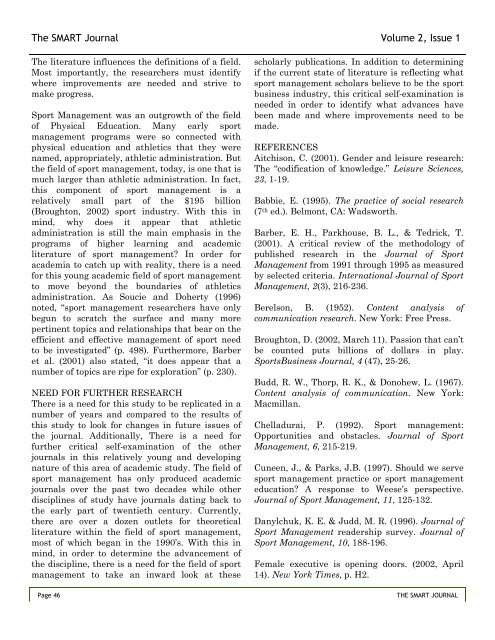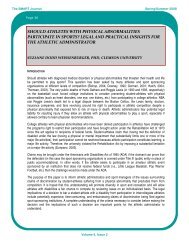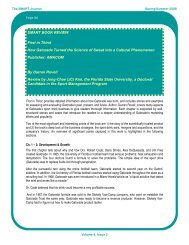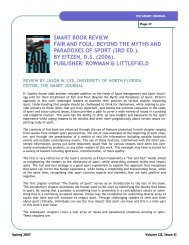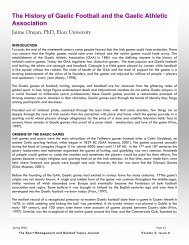examining the body of scholarship in sport management
examining the body of scholarship in sport management
examining the body of scholarship in sport management
Create successful ePaper yourself
Turn your PDF publications into a flip-book with our unique Google optimized e-Paper software.
SMART Onl<strong>in</strong>e Journal Volume 2, Issu e 1The SMART Journal Volume 2, Issue 1The literature <strong>in</strong>fluences <strong>the</strong> def<strong>in</strong>itions <strong>of</strong> a field.Most importantly, <strong>the</strong> researchers must identifywhere improvements are needed and strive tomake progress.Sport Management was an outgrowth <strong>of</strong> <strong>the</strong> field<strong>of</strong> Physical Education. Many early <strong>sport</strong><strong>management</strong> programs were so connected withphysical education and athletics that <strong>the</strong>y werenamed, appropriately, athletic adm<strong>in</strong>istration. But<strong>the</strong> field <strong>of</strong> <strong>sport</strong> <strong>management</strong>, today, is one that ismuch larger than athletic adm<strong>in</strong>istration. In fact,this component <strong>of</strong> <strong>sport</strong> <strong>management</strong> is arelatively small part <strong>of</strong> <strong>the</strong> $195 billion(Broughton, 2002) <strong>sport</strong> <strong>in</strong>dustry. With this <strong>in</strong>m<strong>in</strong>d, why does it appear that athleticadm<strong>in</strong>istration is still <strong>the</strong> ma<strong>in</strong> emphasis <strong>in</strong> <strong>the</strong>programs <strong>of</strong> higher learn<strong>in</strong>g and academicliterature <strong>of</strong> <strong>sport</strong> <strong>management</strong>? In order foracademia to catch up with reality, <strong>the</strong>re is a needfor this young academic field <strong>of</strong> <strong>sport</strong> <strong>management</strong>to move beyond <strong>the</strong> boundaries <strong>of</strong> athleticsadm<strong>in</strong>istration. As Soucie and Doherty (1996)noted, “<strong>sport</strong> <strong>management</strong> researchers have onlybegun to scratch <strong>the</strong> surface and many morepert<strong>in</strong>ent topics and relationships that bear on <strong>the</strong>efficient and effective <strong>management</strong> <strong>of</strong> <strong>sport</strong> needto be <strong>in</strong>vestigated” (p. 498). Fur<strong>the</strong>rmore, Barberet al. (2001) also stated, “it does appear that anumber <strong>of</strong> topics are ripe for exploration” (p. 230).NEED FOR FURTHER RESEARCHThere is a need for this study to be replicated <strong>in</strong> anumber <strong>of</strong> years and compared to <strong>the</strong> results <strong>of</strong>this study to look for changes <strong>in</strong> future issues <strong>of</strong><strong>the</strong> journal. Additionally, There is a need forfur<strong>the</strong>r critical self-exam<strong>in</strong>ation <strong>of</strong> <strong>the</strong> o<strong>the</strong>rjournals <strong>in</strong> this relatively young and develop<strong>in</strong>gnature <strong>of</strong> this area <strong>of</strong> academic study. The field <strong>of</strong><strong>sport</strong> <strong>management</strong> has only produced academicjournals over <strong>the</strong> past two decades while o<strong>the</strong>rdiscipl<strong>in</strong>es <strong>of</strong> study have journals dat<strong>in</strong>g back to<strong>the</strong> early part <strong>of</strong> twentieth century. Currently,<strong>the</strong>re are over a dozen outlets for <strong>the</strong>oreticalliterature with<strong>in</strong> <strong>the</strong> field <strong>of</strong> <strong>sport</strong> <strong>management</strong>,most <strong>of</strong> which began <strong>in</strong> <strong>the</strong> 1990’s. With this <strong>in</strong>m<strong>in</strong>d, <strong>in</strong> order to determ<strong>in</strong>e <strong>the</strong> advancement <strong>of</strong><strong>the</strong> discipl<strong>in</strong>e, <strong>the</strong>re is a need for <strong>the</strong> field <strong>of</strong> <strong>sport</strong><strong>management</strong> to take an <strong>in</strong>ward look at <strong>the</strong>sePage 46scholarly publications. In addition to determ<strong>in</strong><strong>in</strong>gif <strong>the</strong> current state <strong>of</strong> literature is reflect<strong>in</strong>g what<strong>sport</strong> <strong>management</strong> scholars believe to be <strong>the</strong> <strong>sport</strong>bus<strong>in</strong>ess <strong>in</strong>dustry, this critical self-exam<strong>in</strong>ation isneeded <strong>in</strong> order to identify what advances havebeen made and where improvements need to bemade.REFERENCESAitchison, C. (2001). Gender and leisure research:The “codification <strong>of</strong> knowledge.” Leisure Sciences,23, 1-19.Babbie, E. (1995). The practice <strong>of</strong> social research(7 th ed.). Belmont, CA: Wadsworth.Barber, E. H., Parkhouse, B. L., & Tedrick, T.(2001). A critical review <strong>of</strong> <strong>the</strong> methodology <strong>of</strong>published research <strong>in</strong> <strong>the</strong> Journal <strong>of</strong> SportManagement from 1991 through 1995 as measuredby selected criteria. International Journal <strong>of</strong> SportManagement, 2(3), 216-236.Berelson, B. (1952). Content analysis <strong>of</strong>communication research. New York: Free Press.Broughton, D. (2002, March 11). Passion that can’tbe counted puts billions <strong>of</strong> dollars <strong>in</strong> play.SportsBus<strong>in</strong>ess Journal, 4 (47), 25-26.Budd, R. W., Thorp, R. K., & Donohew, L. (1967).Content analysis <strong>of</strong> communication. New York:Macmillan.Chelladurai, P. (1992). Sport <strong>management</strong>:Opportunities and obstacles. Journal <strong>of</strong> SportManagement, 6, 215-219.Cuneen, J., & Parks, J.B. (1997). Should we serve<strong>sport</strong> <strong>management</strong> practice or <strong>sport</strong> <strong>management</strong>education? A response to Weese’s perspective.Journal <strong>of</strong> Sport Management, 11, 125-132.Danylchuk, K. E. & Judd, M. R. (1996). Journal <strong>of</strong>Sport Management readership survey. Journal <strong>of</strong>Sport Management, 10, 188-196.Female executive is open<strong>in</strong>g doors. (2002, April14). New York Times, p. H2.THE SMART JOURNAL


